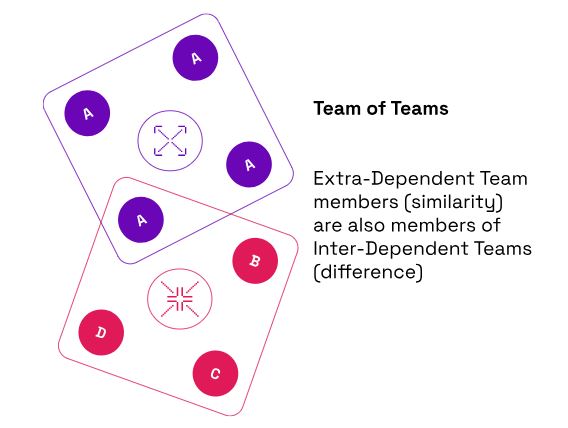Teams are vital to organisations as they provide both the method of performing and the sense of belonging that ensure organisations knit together to achieve what is expected of them. We all have an idea of how teams ought to work well based on expectations and experiences. In organisations such expectations can be difficult to achieve as we can find ourselves in multiple teams simultaneously. Our mental model of teams doesn’t typically allow for multiple teams.
This short introduction to Inter-Dependent and Extra-Dependent Teams provides some explanation around how people can be in multiple teams simultaneously. It explores how these different types of teams are distinct from each other – including their purpose and dynamics – and how they complement each other to enable the wider organisation to perform better whilst having a strong sense of belonging and purpose.
When Is a Team a Team?
The first hurdle we meet is understanding what we mean by team. It’s useful to appreciate that people often mean different things when they use the word and with these different meanings comes some confusion. We break down this thinking into three levels:
Level 1 Thinking
In level 1 thinking, teams are defined by sharing the same line manager. Calling something a team doesn’t make it behave like one. A line managed group will defer decisions to the line manager, communicate through them and generally not contribute much more than the line manager can on their own. This doesn’t generate synergy – greater than the sum of the parts.

Level 2 Thinking
Level 2 thinking is the result of wanting to achieve synergy and achieves this through interdependency. For teams to depend on each other, everyone typically needs to contribute something uniquely different that everyone else in the team relies on in order to achieve something no-one could achieve on their own.

Level 2 thinking makes a great deal of sense, is well researched and is popularised in action movies around the world. The problem with it is that it assumes all teams should become interdependent and because not all teams are structured around different skills and roles, there needs to be a Level 2 thinking – where two types of teams are appreciated for what they are.
Level 3 Thinking
This level of thinking recognises that there are two types of teams in organisations, and that both Inter and Extra-Dependent teams can function and that both types of teams can perform.

It breaks with the assumption that ALL teams can become interdependent and instead appreciates that some teams consist of people who don’t depend on each other – and that’s OK. In such teams, members depend on people outside the team – and such external stakeholders depend on individual team members rather than the whole team. Teams with this dynamic are commonplace in organisations but unrecognised. We have called them Extra-dependent teams because of this outside dependency. It also helps highlight one of their fundamental differences from Inter-Dependent teams.
Recognising both types of teams helps to explain and manage dynamics where people are in multiple teams simultaneously. This helps to appreciate organisations as human systems, and the relational nature of those dynamics.
Both teams complement each other to support organisational systems, without teams having to compete with each other.

Let’s look at the team types for Inter and Extra-Dependent Teams in more detail.
Inter-Dependent Teams
How they work
In Inter-Dependent teams everyone plays a part in working together towards a common goal. Difference in people’s roles and responsibilities is vital. Such difference ensures mutual dependency between members which ensures that they have to work together in order to achieve the required outcome. If one person doesn’t perform then everyone is affected. It means team members support and challenge each other in order to get what they truly desire – the common goal.
When they don’t work
When Inter-Dependent Teams fall apart, it’s because some element isn’t working. Sometimes it’s because the goal isn’t clear, or isn’t understood. At other times it’s because one or more people aren’t performing in their roles and the other team members aren’t either supporting, or perhaps challenging their team mates enough so that the part they play is sufficient to achieve the goal. Or perhaps it’s because the way the team works together doesn’t combine all the differences in a way that brings out the best in people; maybe one person dominates, or one person is ignored, or perhaps one person doesn’t turn up or even communicate with the others.
Extra-Dependent Teams
But some teams in organisations have similar symptoms yet they are not dysfunctional. Such teams might never work together and that’s OK. They might only occasionally communicate with each other and that’s fine. Indeed, they might not all attend a scheduled meeting and it doesn’t necessarily affect anyone else in the team. And importantly, such teams are marked out by having roles and responsibilities that are very similar to each other rather than different. These are Extra-Dependent Teams.
How to Spot an Extra-Dependent Team
A hallmark of such teams is similarity in roles rather than difference. In organisations they appear everywhere: sales, project managers, risk managers, investigators, business partners, regional managers, the list goes on. In Extra-Dependent Teams, members don’t work together because they work instead with people outside the team. For a project manager to do their work, they need to work with other people (with different roles) outside the team. Only then are they being productive in their role as a project manager. That is why they are called Extra-Dependent – because they depend on people outside of the team when performing.
What Makes Them Distinct
Extra-Dependent Teams are prevalent within organisations because they share a specialism that the organisation depends on. This specialism is typically provided by each individual member, rather than the team as a whole. Extra-Dependent Teams therefore have a common practice – they all do similar work sharing a repertoire of skills, processes, knowledge, stories, language, working standards and professional identity. They individually weald this common practice and people outside the team need it in order to do their work. Sales people work with clients, project managers work with others on projects, risk managers work with those taking the risks, business partners work with business teams, and regional managers work with their regions.
Yet teaming within Extra-Dependent Teams is just as important as in Inter-Dependent Teams – only it is done differently to reflect the different factors within each type of team.
How to Distinguish the Inter-Dependent and Extra Dependent Teams
| Factors | Inter-Dependent | Extra-Dependent |
| Purpose | Working together to achieve a common goal | Learning together to develop a common practice |
| Dependency | Inside | Outside |
| Skill mix | Different | Similar |
| Bond | Common goal | Common practice |
| Accountability | Mutual | Individual |
| Improvement | Working together better, to achieve more ambitious objectives | Learning better together, to deliver better consistency, value and quality |
What Makes an Extra-Dependent Team Work
Key to teaming within an Extra-Dependent Team is sharing the practice between each other through learning better together. This is not working together to achieve something, but sharing successes, mistakes, challenges, ideas, new innovations and many other things. It’s about how each person goes about their work individually and how such practice is adopted across the team. Such sharing requires high levels of trust in order to be open about what techniques people use and how they work or not. It also requires coming together to share, support and encourage each other in developing a common practice.
It requires lots of time away from each other in order to apply their practice. Too much time together means those who depend on the expertise outside the team can’t perform. But not enough time together in the Extra-Dependent Team and there is not enough sense of “us” – a key ingredient in the identity that bonds the team together and provides a strong sense of belonging.
Team of Teams
Understanding these differences helps understand how people can belong and perform in different teams at the same time without clashing. (Which team’s goal is more important? Which is the “home” or “first” team?). The picture below highlights how members of Extra-Dependent Teams are simultaneously members of Inter-Dependent Teams.

Here you can see how each member of an Extra-Dependent Team works individually within another Inter-Dependent Team. It’s important that such people feel and act as legitimate members of BOTH teams.
A well-working Extra-Dependent Team will learn together to bring improved capability to their Inter-Dependent Team. This means both teams are equally important and both complement each other. This means that not only is each team is stronger, but the teams are both stronger because of each other team. This is truly a team of teams.
Being Effective as an Extra-Dependent Team
Extra-Dependent Team can be likened to “herding cats” – everyone acts individually rather than together. Being an effective member of an Extra-Dependent Teams means:
- Acknowledging that you are in an Extra-Dependent Team
If people do much the same thing but don’t work together as a team, then accept that you are an Extra-Dependent Team, not an Inter-Dependent Team. It’s OK!
- Extra-Dependent Teams are OK
Extra-Dependent Teams occur naturally – they were first recognised as Communities of Practice which have been around for millennia. People are drawn together by being similar rather than different. They get comfort, support, learning, and a sense of identity from coming together. They have a strong sense of “us” which can be used to great benefit.
- Extra-Dependent Teams have a common practice rather than a common goal
Their practice is made up of their skills, equipment, processes and things such as stories and traditions. For instance, the Hippocratic Oath is a requirement of being a doctor – it is a key part of the practice of what makes all doctors similar (and different from everyone else).

- Extra-Dependent Teams learn together, they don’t work together
The sense of “us” is developed and honed by helping the Extra-Dependent Team to learn together. They learn together within their unique organisation. How do we do our work here? What unique requirements do we have within this organisation? What standards do we wish to work to here?
- The dynamics of Extra-Dependent Teams are different from Inter-Dependent Teams
Extra-Dependent Teams have layers of membership associated with who represents best practice for that team. These are “Elders” who are role models for “Newcomers”. Yet Newcomers also provide different experiences and question assumed ways of doing things which the Elders need to listen to for the whole team to learn and integrate.
- Improvement and Innovation are easier
The whole team is able to generate improvements in how they go about their work. This might be from spending more time understanding each other, sharing practice, sharing strengths (so that everyone is strong rather than just one or two) and creating greater consistency across the team. When such learning is facilitated well and the team is encouraged to experiment and develop, the team can achieve new innovations. This not only helps their practice, but in doing so, helps others in the organisation to achieve more. Such teams therefore have the potential to have a strategic impact on the whole organisation.
When all these things are acknowledged and understood, Extra-Dependent Teams have the potential to achieve the same sorts of synergies promised by Interdependent Teams:
1 + 1 + 1 = 6
Resources on Extra-Dependent Teams
The Organisational Coaching Hub resources site has loads of videos, articles, and tools to support understanding, leading and developing Extra-Dependent Teams. The Team Dependency Diagnostic in particular provides a clear indication of any team of functionality and team-type, be it Inter-Dependent, Extra-Dependent or both!
Questions for consideration
- Where do you experience these teams?
- What does this help to clarify?
- How does this challenge your own thinking?
Further Reading
Hawkins, P. (2014). Leadership Team Coaching in Practice: Developing High-Performing Teams
Kesby, D. (2019). Extra-Dependent Teams: Realising the Power of Similarity
Lencioni, P. (2002). The Five Dysfunctions of a Team
Wenger, E. (1998). Communities of Practice; Learning, Meaning and Identity


